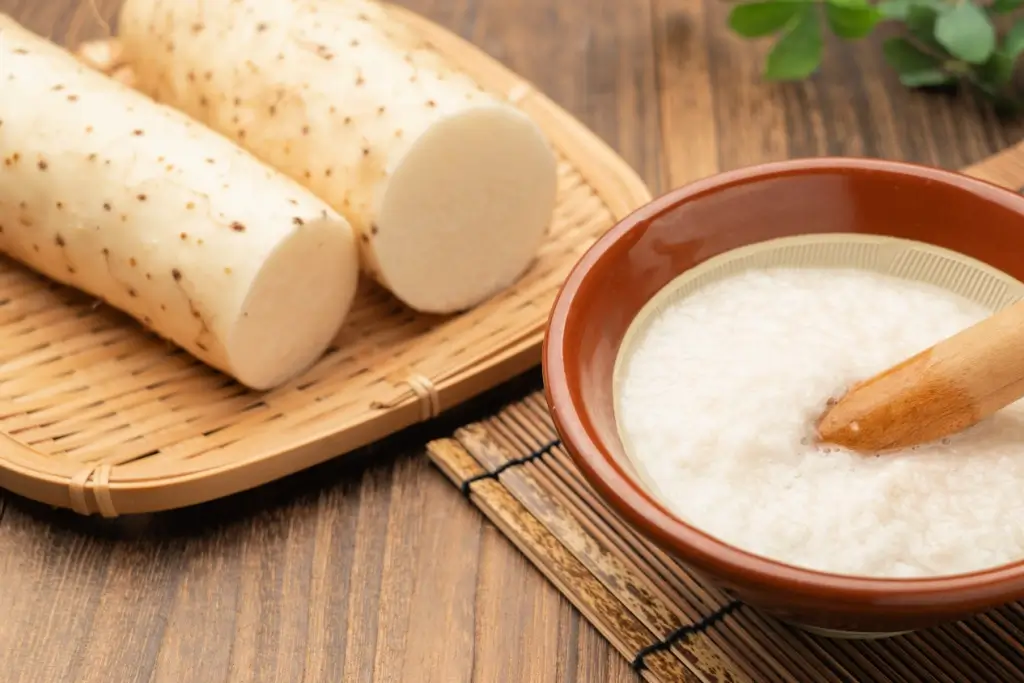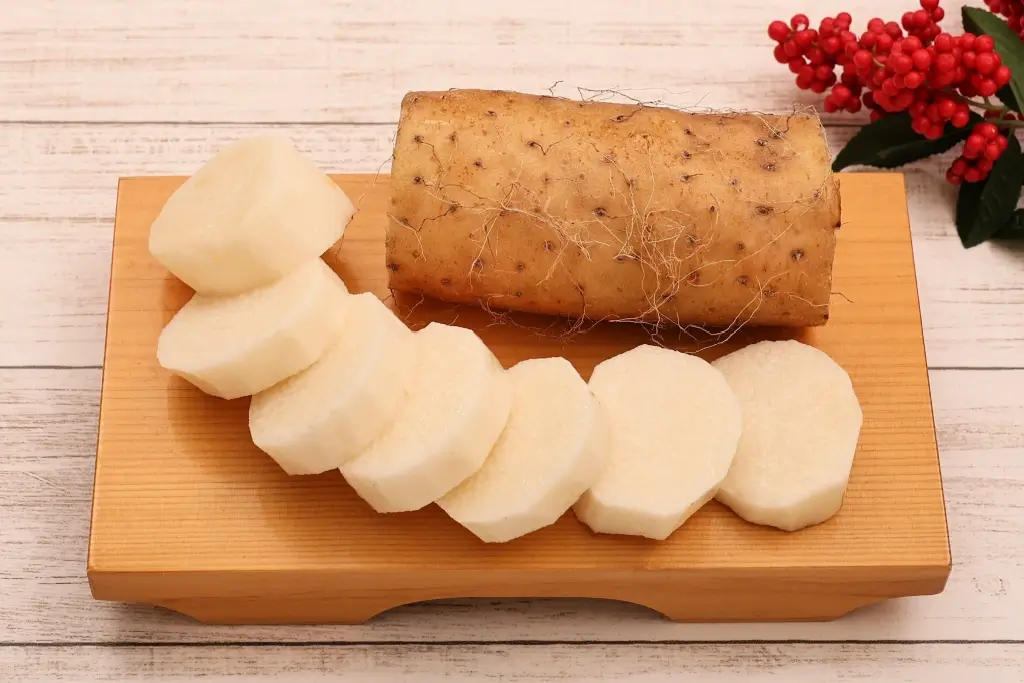Japanese cuisine highlights ingredients’ natural flavors and creates the perfect combination of nutrients from those ingredients. Root vegetables are one of the main ingredients commonly used in many traditional dishes and daily meals. So, let’s explore the most popular root vegetables in Japan, starting with nagaimo!
Table of Contents
ToggleNagaimo
Nagaimo, also known as the Japanese mountain yam, is a versatile and unique tuber enjoyed in East Asia for centuries. Although it originated in China, nagaimo is now widely cultivated in Japan, particularly in Aomori Prefecture. Its light brown skin and crisp white flesh make it easily recognizable.

It can be sliced into crisp matchsticks for salads, used as a natural thickener in okonomiyaki batter, or added to miso soup for a comforting flavor. People also eat it raw or grated, perfect for dishes like tororo gohan (grated yam over rice) or yamakake (grated yam with raw tuna).
It’s a healthy ingredient, too! Packed with dietary fiber, vitamin C, potassium, and iron, nagaimo supports digestion and strengthens the immune system. Fall nagaimo has a mild nutty flavor, while spring ones are sweeter. This dual harvest cycle means fresh nagaimo is almost always available in Japan’s markets.
Burdock Root
Gobo (burdock root) is a long, slender vegetable cherished for centuries. Originating from Asia and Europe, it found its way to Japan during the Heian period (794-1185) as a medicinal herb. At first, people used it because they believed it could clean the body and lower fevers. But by the mid-Heian era, people started incorporating it into their meals.
This vegetable has rough beige skin and pale ivory inside. It grows up to three feet long and is harvested mainly in autumn and winter. In Japan, different varieties are grown with unique features. Takinogawa burdock from Kanto is known for its long, sturdy roots, while shorter types like Horikawa burdock from Kyoto are popular in Kansai.

Gobo is rich in fiber, minerals, and antioxidants that protect cells, reduce inflammation, and support detox. In traditional Japanese medicine, burdock root cleanses the blood and boosts kidney function. Burdock root has a mildly sweet taste with a hint of nuttiness. When eaten raw, it’s crisp like a radish but becomes soft and tender when cooked. In Japanese cuisine, this vegetable shines in kinpira gobo, where it’s sliced with carrots and cooked in soy sauce, mirin (cooking rice wine), and sesame oil for a sweet and savory flavor.
It’s also a favorite in miso soup and takikomi gohan (mixed rice), where its slight bitterness complements the umami flavors. For a fun twist, pickled burdock is often used in sushi rolls, while fried burdock chips offer a crunchy, potato-like snack.
Are you looking for great snacks that might feature root vegetables? Check out Sakuraco! Sakuraco delivers traditional Japanese snacks, teas, and sweets from local Japanese makers directly to your door so you can enjoy the latest treats directly from Japan!
Taro root
Taro root, or satoimo, is a starchy root vegetable that has been a part of Japanese cuisine for thousands of years. It has been cultivated since the Jomon period (14,000-1000 BC). In Japan, it’s known as “the potato of the homeland” because it was a staple food before rice became more popular.

It has a firm, creamy flesh with a slightly slimy feel. When cooked, its nutty flavor becomes tender, sweet, and savory. It is rich in starch, which makes it filling and satisfying, and it is high in fiber, potassium, and vitamin C. Taro root is an excellent food for supporting healthy digestion, lowering blood pressure, and improving joint health.
It’s used in various delicious Japanese dishes. One favored dish is kenchinjiru, a hearty vegetable soup with tofu and mushrooms. Satoimo is also used to comfort nimono and is simmered in dashi (fish stock) with other vegetables. Plus, it’s even found in bento boxes, boiled or roasted as a tasty side dish. In addition to these savory uses, taro root is also enjoyed in sweets, such as daigaku imo (caramelized taro dessert).
Sweet potato
Sweet potatoes, known as satsumaimo in Japan, are a beloved root vegetable with a rich history and cultural significance. They came from Central and South America and reached Japan in the 17th century through the Ryukyu Kingdom, now Okinawa. They were introduced to Satsuma Province (modern Kagoshima), which gave the vegetable its Japanese name. Sweet potatoes became an essential crop in the country as they were strict and nutritious, especially during famines.
Satsumaimo is creamy, fluffy, and naturally sweet with an earthy flavor like chestnuts. Their reddish-purple skin and pale yellow or vibrant purple flesh add visual charm to their culinary versatility. They can be enjoyed in many ways: roasted whole as yaki-imo, mashed into New Year’s dishes like kuri kinton, or deep-fried and candied as imo-kenpi.

Their flavors shine in desserts, from cakes and puddings to ice creams. Furthermore, they’re also a key ingredient in traditional dishes like imo-gohan (sweet potato rice) and nimono. In Kyushu, sweet potatoes are used to craft imo-shochu, a standard alcoholic drink.
Japan grows over 100 types of sweet potatoes, including the honey-sweet Beni Haruka, creamy Beni Kirishima, and the rich purple Beni Imo from Okinawa. These varieties are celebrated at festivals like the Shinagawa Yakiimo Terrace, where visitors enjoy roasted sweet potatoes with warm milk or under a cozy kotatsu.
Kabu Turnip
Kabu turnip has a rich history dating back to 700 CE when it was first introduced to Japan. These small, white, globe-shaped roots grow well in Japan’s changing seasons. Japan cultivates numerous kabu varieties such as Hakurei, Tokyo turnips, and Salad turnips. Known for its soft texture and mild, sweet flavor, kabu turnip has become a staple in Japanese cuisine, particularly in dishes that highlight its natural taste.

When eaten raw, the roots are crisp and sweet and become buttery and soft when cooked. Their flavor is often described as a mix of radish and turnip with earthy and nutty flavors. The bright green tops, which are also edible, offer a mild taste and are perfect for sautéing or stir-frying. Kabu turnips are a favorite in miso soup, tsukemono (pickled things), and winter comfort foods.
Why are vegetables like nagaimo unique?
Vegetables like nagaimo are unique because of their versatility and rich flavors, which connect us to Japan’s agricultural heritage. These vegetables can adapt to different cooking methods, showcasing their depth of flavor and texture. Moreover, they are not only tasty but also wholesome!

They can support healthy blood pressure levels and contribute to overall wellness, making them a great addition to any diet. Have you ever tried Japanese root vegetables, and which is your favorite? Share with me in the comments!










